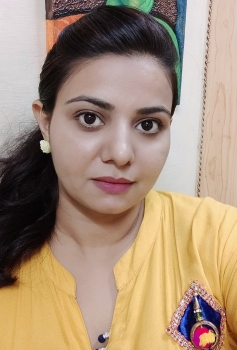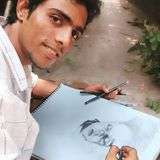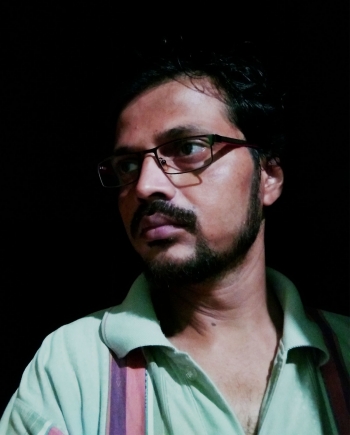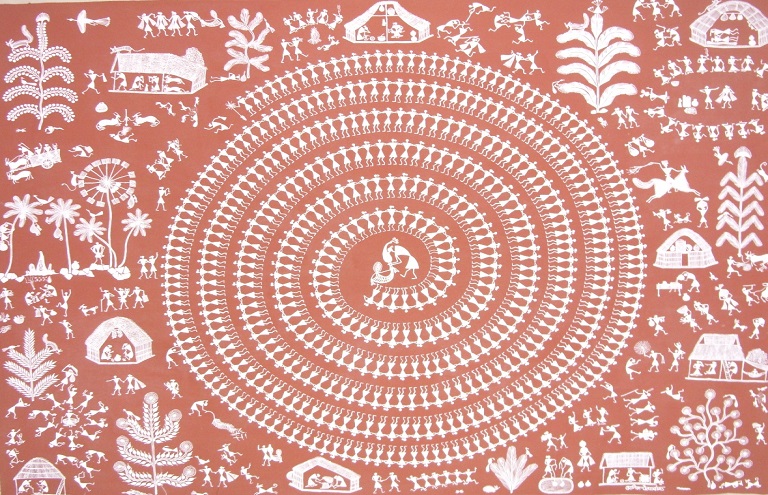The diversified borders of India not only mark the onset of a variety of cultures but also their respective traditional art. Despite all the vivid and enchanting crafts available in every corner of the country, each traditional painting works towards depicting the beauty of every culture, custom, ideology, and generation.
While many of the traditional paintings and artworks existed as wall paintings and murals, the rising of urbanization brought the idea of painting on paper canvas, cloth, sand, and whatnot. Such artwork is known to set a specific example of expression through art with the help of a variety of compositions.
Dating back to thousands of years, traditional Indian art has been able to survive but does need its due revival and appreciation. Well, while we understand the evolution of the traditional form of art and paintings, let’s have a look at the variety that India has to offer under the idea of Tradition Art.
1. Tanjore Paintings
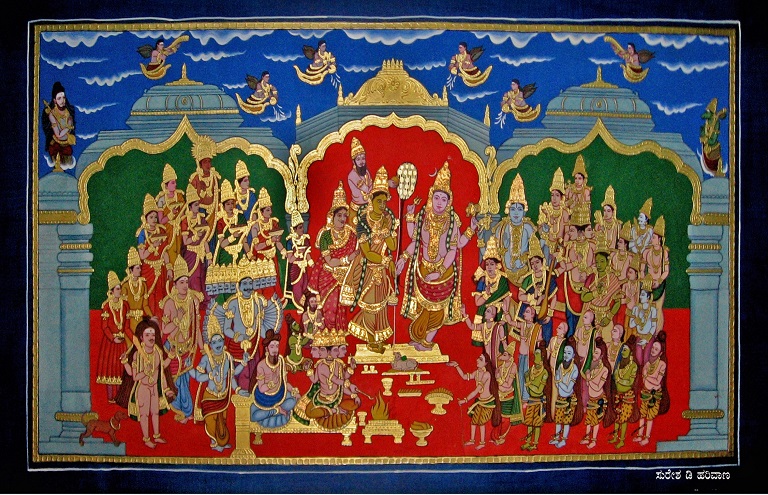
https://indianartideas.in/artwork/girijakallyana/13411
Been recognized as the Geographical Indication in 2007-08 by the Government Of India, Tanjore Paintings is known as the Classical South Indian art developed in the late 16th century. Risen from the roots of the Thanjavur, the Capital of Erstwhile Chola Empire, Tanjore Painting is said to evoke the sense of timelessness and class along with the puranic scenes which are alluring and surreal. This kind of painting is known to be popular amongst Women in contemporary India- showcasing their very own artistic sides and inclinations.
Tanjore Painting and its History
- Originated under the Murals of the Vijayanagara Period of 1500-1600 AD, Tanjore paintings are known to be the Robust form of the architectural details and vibrant colors of the same.
- With the rising of the Maratha Rule in the next century, a distinctive change in the style was bright. The professional traditional Indian artists came up with the combination of the existing Murals and detailed it with the help of the precious stones and Gold Leaves.
- Two of the old communities practiced this form of traditional art namely- The Rajus Of Tanjore and Trichy and the Naidus Of Madurai.
What are Tanjore Paintings Subjected to?
- Hindu Gods and Goddesses
- Hindu Saint Episodes from Hindu Religious Books
- Text Visualisation
- Sketched paintings
- Several other religions such as Jain, Sikh, and Muslim are also depicted
What Does a Main Tanjore Traditional Painting consist of?
- A proper Tanjore Painting is known to consist of a single figure which is the point of focus, usually a Deity.
- It is known to hold a rounded face, Body, and Eyes shaped in Oval.
- The main figure is enclosed with the help of arches and curtains.
What are the Features of a Tanjore Painting?
- Rich, Vivid, and Flat colors are used in Tanjore Paintings
- Decorated using semi-precious stones to give a glowing effect to the structure and ornaments.
- To give a radiant shine to the painting, 22 carats was also used initially.
2. Madhubani Painting
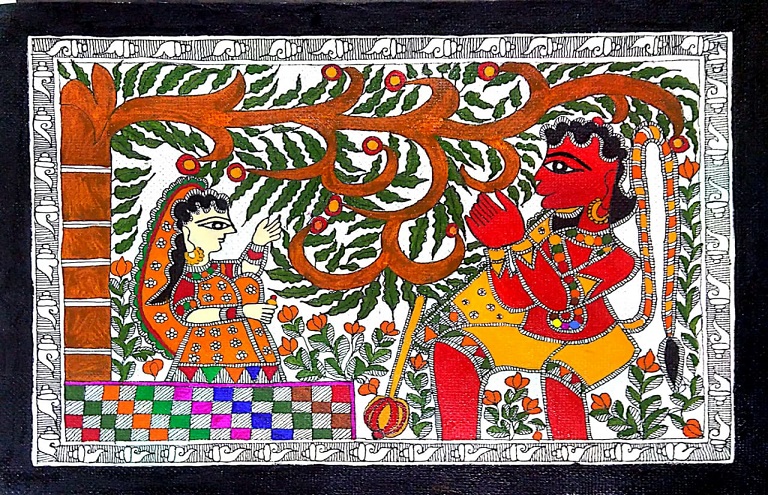
https://indianartideas.in/artwork/ashok-vatika/16758
Madhubani which originated in the Mithila region of Bihar is known to be one of the most celebrated Traditional Indian Art. This type of spectacular art form was unknown to the people of India until the Britishers discovered it in 1934. This came into the limelight during the inspection of a massive Bihar earthquake. The beauty of Madhubani is said to be held within the simple portrayal of the traditions and cultures of Bihar. The eye-catching geometrical patterns, when combined create mind-boggling images and scenes from the mythology. Madhubani holds in a combination of vibrant colors and simple patterns- helping it to stand out.
Madhubani Painting and its History
- Traditionally, it was created by the women of a variety of communities in the Mithila region.
- Originated from the Madhubani DIstrict of Mithila, Bihar. It was and is one of the major export centers of such paintings today itself!
What Does a Main Madhubani Traditional Painting consist of?
- Madhubani Paintings initially consisted of freshly plastered floors and mud walls of the hut; but now, they are also done on handmade paper, cloth and canvas. They are usually made out of the paste of the powdered rice
- It is known to be a 2D painting of imagery along with the colors extracted from plants.
- Known to depict individuals and their associations along with the environment. The scenes and deities are depicted from ancient epics. Madhubani paintings are also known to depict natural elements such as the sun, the moon, the stars, and especially religious plants such as Tulsi.
- Scenes from the royal court are depicted beautifully along with events such as weddings.
- Under the art of Madhubani Painting, no space is left empty- the gaps found are filled in with animals, flowers, birds, and mostly with geometric patterns.
What are the Features of a Madhubani Painting?
- There are five types of Madhubani Paintings, namely- Kutch, Tantrik, GOdna, Kohbar, and Bharni. While Bharni and Tantrik variants were made by Brahmin women in India and Nepal- images and scenes from religious stories were depicted.
- While the above-mentioned point was usually followed by ‘Upper Caste ‘women; the ‘Lower Caste’ included the daily aspects of life and symbols. Most of the paintings showcased day-to-day stories in their paintings.
- Today, Madhubani paintings have been recognized as a global art- ending the caste-based work system.
3. Miniature Painting
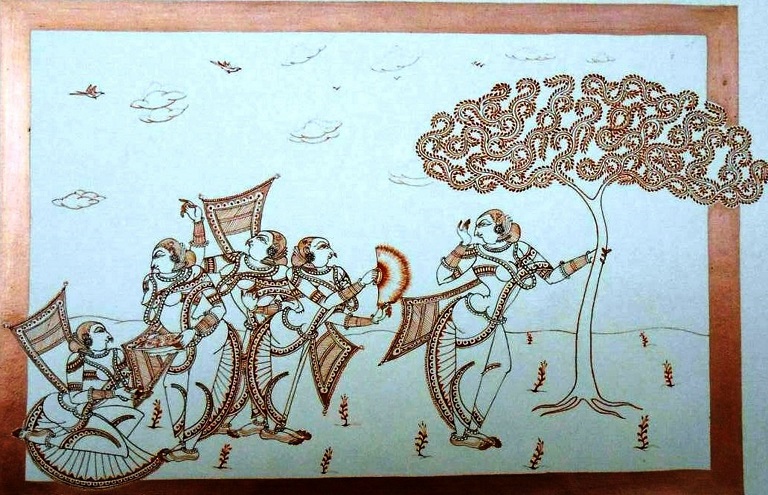
https://indianartideas.in/artwork/traditional/12820
While the style of Miniature painting comes from the rise of Mughals in the 16th Century, they are identified to be an important milestone in the era of Traditional Indian Art. Miniature Painting is usually combined with Islamic, Persian, and Indian elements- enhancing the beauty and traditions.
What is the History of Miniature Painting?
- While they provide an artistic intimacy, Miniature painting of India has a glorious history to learn from.
- They are not just created to observe, but to be read from head to toe just like a story.
- The first miniature painting of India was dated back to the 7th Century. Since then, the style of miniature painting has taken various transformations. From the use of simple and subdued color tones- usage of exaggerated physical traits and bold colors are seen.
What are the main attributes of Miniature Painting?
- This type of traditional art is pursued using natural stone colors on ‘WASLI’, ie, paper-based.
- Mineral colors, conch shells, silver, gold, and precious stones are used in miniature paintings.
- The unique attributes of miniature paintings are firm brushwork, detailing, intricacy and stylization.
- This kind of painting has developed and grown into distinct schools like that in Kangra, Rajasthan, Pahadi, Mughal, Deccan, etc.
4. Phad Paintings
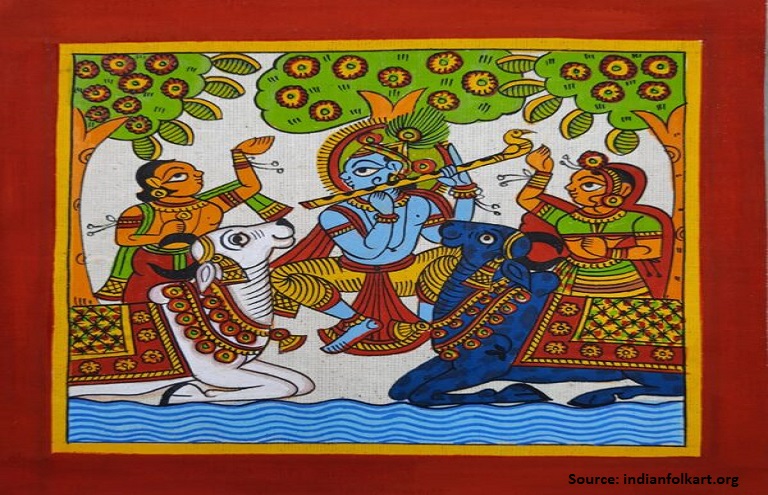
The traditional art of Phad Painting is known to be a narrative scroll painting rooted in Rajasthan. While the traditional painting form dates back a thousand years, it is known to depict stories of local heroes, gods, and goddesses. They are painted on a horizontal cloth scroll- red, yellow, and orange in hues.
What does a Phad Painting Depict?
- The scrolls of Phad Painting are known to show the depictions of adventurous stories, battlefields, the richness of the Indian Princely States, and battlefields.
- They are known to be left spellbound at how the traditional folk artists and their stories are accommodated in one single composition- maintaining the ethnicity of artistic expression.
What is the History of Phad Painting?
- Being stated as an indigenous painting, this type of traditional artform is a blend of Rajput and Mughal styles.
- It is a fabled heritage of Bhilwadi and depicts the folk stories of Pabuji and Gurjar Warriors. Devnarayani is also depicted in the same.
- The storytellers, in ancient times, would travel from one village to another narrating stories using Phad Paintings (as a pictorial depiction tool).
What Is The Technique Used While Creating A Phad Painting?
- They are known to be a very detailed form of traditional Painting.
- As we read above, Phad Paintings were used for storytelling - a lot of human figures are seen the same. Also, the size and color of the individuals depend on the position and role of the same.
- A thick or fine paste of rice flour is used to initiate the painting on a cloth. It is prepared by boiling the mixture of the same in water and is dried in the sunlight post applying it on the cloth.
- Once the cloth is ready to post rubbing the Mohra or the stone to it, the painting is ready to be made with utmost smoothness and shine.
- Once the cloth is ready to be made, natural colors from plants and vegetables are used to paint the earthen colors- enhancing the acrylic look.
5. Warli Painting
https://indianartideas.in/artwork/tribal-dance-tarpaa/3163
The ancestral roots of Warli Paintings come from regions of Maharashtra, namely- Thane and Nasik- which is known to be linked with Nature and social tribal rituals. While they portray the daily activities through Warli paintings, local people tend to like hunting, praying, dancing, and farming. In ancient times, women used twigs to create lively designs with the help of rice paste on the walls of huts. This marked the celebration of any wedding or harvest. Warli paintings are made of geometric patterns on a white background against the yellow and red depicting the daily life events of the tribals.
What is the History of Warli Painting?
- Stated as one of the oldest and largest tribes of India, the Warli Tribe is located on the outskirts of Mumbai. Being located in India's one of the finest growing modern societies, the Warli Tribals refused to be infused with the contemporary lifestyle and cultures.
- The origin of Warli Painting can be traced back to nearly 3000 BC. This type of painting was painted around the concept of mother nature and its various elements.
Styles and Design Of Warli Painting
- At the point when one gander at a Warli painting, the unpredictable mathematical examples of blossoms, chasing scenes, wedding customs, and some other exercises make the artistic creations stick out.
- A specific allure for the composition comes from its excellent yet sensitive examples. The latest thing among fashionistas and home products brands is to pick these plans and models.
- Warli ancestral workmanship can be found on an assortment of items and spots throughout the planet.
- Individuals from Maharashtra have an exceptional feeling of conclusion connected to the Warli artistic creations of Maharashtra since they've seen them on the dividers of different provincial schools and homes way before they acquired prevalence.
6. Gond Paintings
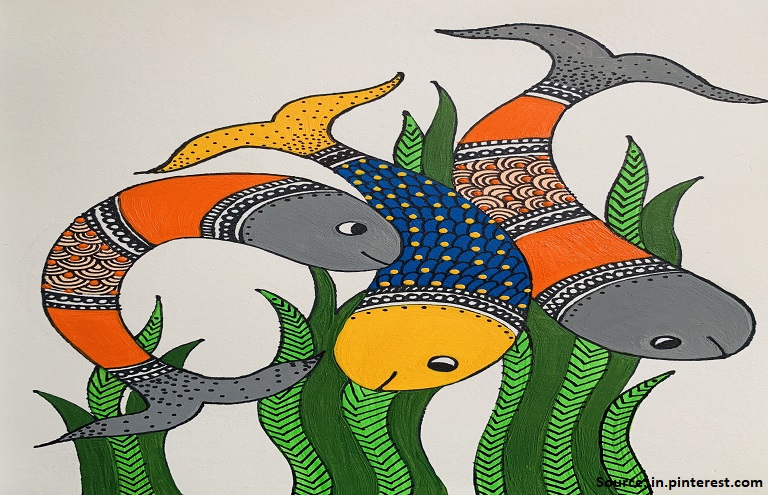
These energetic works of art made with a progression of complicatedly masterminded dabs and runs were created by the Gondi clan of focal India. The tribals reproduce fanciful stories and oral narratives to customary tunes, normal environmental factors, significant occasions, and ceremonies with incredible multifaceted design, rich itemizing, and brilliant tones. Generally, colors were gotten from regular assets like cow compost, plant sap, charcoal, hued soil, mud, blossoms, leaves, and so on Gond specialists presently utilize business water-put-together tones to paint concerning paper and material.
History Of Gond Painting
- The historical backdrop of the Gond public dates almost 1400 years. Artistic creations just as other fine arts have consistently been very mainstream with ancestral individuals in India, particularly the Gond clan.
- The Gond public has a conviction that reviewing a decent picture brings forth amazing good fortune and they design their dividers and the floor of their homes with customary tattoos and themes.
- Among the Gond, it is the most unmistakable among the Pardhan Gonds who are prestigious for their creative abilities, be it painting or music.
- Gond artistic creations have likewise been utilized by the Gond individuals as an approach to record their set of experiences.
What Inspired the Discovery of Gond Paintings?
- As per the Gond conviction, everything is occupied by a soul and, therefore, is consecrated. Gond artistic creations are an impression of man's nearby association with his normal environmental elements.
- While a greater part of Gond artistic creations does take motivation from nature, it isn't the lone wellspring of thoughts. They additionally go to the fantasies and legends of India or grandstand pictures from the regular routines and dreams in their craft.
Process To Get the Best Gond Painting
- Gond canvases can be portrayed as 'online work'. The workmanship is made out of painstakingly defined boundaries. Lines are utilized in such a manner to pass on a feeling of development to in any case pictures.
- Specks and runs are added to confer a more noteworthy feeling of development and increment the measure of detail.
- One more exceptionally striking aspect of Gond canvases is the utilization of brilliant distinctive tones like white, red, blue, and yellow.
7. Kalamkari Paintings

https://indianartideas.in/artwork/shiva-and-nandi/17399
This 3000-year-old traditional art of hand and square printing was customarily utilized for making account parchments and boards. This flawless society craftsmanship has a solid interface with Persian themes. Kalamkari gets its name from kalam or pen and is a heritage that has been given over from one age to another in Andhra Pradesh. The stylized creature structures, botanical themes, and Mehrab plans transcendent in Kalamkari canvases have additionally discovered a spot in Kalamkari materials. Kalamkari workmanship essentially includes natural shadings like indigo, green, rust, dark, and mustard.
The Origin of Kalamkari Paintings
- Kalamkari workmanship and printing are moved principally in Andhra Pradesh, especially in Kalahasti and Machilipatnam, and a couple of other more modest areas of the state. Srikalahasti was the principal focal point of kalamkari workmanship for a vital explanation: it got a steady inventory of clean waterway water.
- Kalamkari craftsmanship was the family control of a few country ladies and experts in the old occasions and keeps on being passed down starting with one age then onto the next. Andhra Pradesh is as yet the principal center of kalamkari imprinting in the country.
- Skilled workers occupied with kalamkari workmanship needed to later modernize a portion of the old, Hindu-folklore enlivened kalamkari subjects because there was an expanding interest for these prints in the global market.
- In this manner, Persian workmanship gradually became one of the significant impacts on the first kalamkari plans.
Why are Kalamkari paintings in sheer demand?
- An expanding number of individuals all over the globe are currently debilitating the utilization of destructive synthetics underway and producing.
- In such a situation, kalamkari arises as to the ideal art since it stays away from the utilization of counterfeit synthetic substances and still creates delightfully hued textures.
- Today, ladies in the nation can search for a scope of various kalamkari printed outlines including kurtas, sarees, and dupattas in stunning plans and tones!
8. Kalighat Paintings
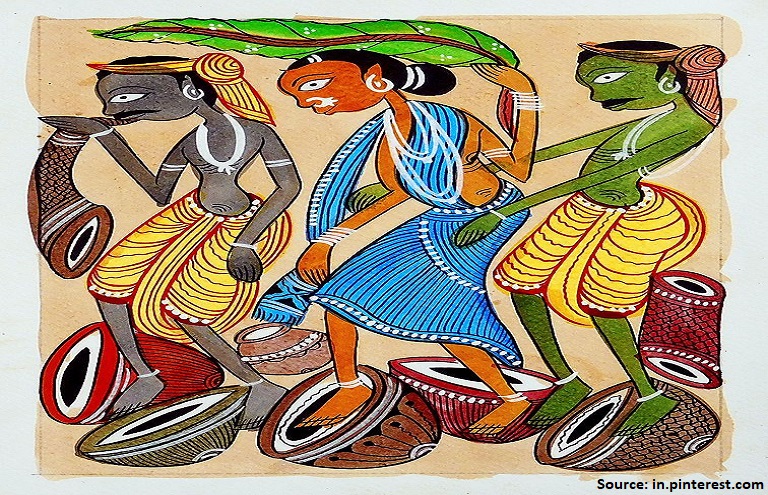
The Kalighat painting style was created around the Mid-nineteenth century in the neighborhood of Kali Temple in Calcutta. These drawings on paper were finished by a gathering known as "patuas", consequently the name Kalighata Pata.
They portrayed scenes of regular day-to-day existence and fanciful divinities in a straightforward yet charming way and formed into the well-known kali ghat way of painting. Kalighat painters prevalently utilize hearty Indian tones like indigo, ochre, Indian red, dark, blue, and white. The quick, consistent, free-streaming framework is a recognized quality of the Kalighat style of canvases. This artwork style has motivated numerous craftsmen, the most well-known being Jamini Roy.
History Of Kalighat Painting
- In what was named the "Oriental school" of Kalighat painting, transcendent subjects focused on strict figures and scenes from hallowed texts, from goddesses Durga and Lakshmi, to the characters of Rama and Sita in the antiquated epic sonnet of Ramayana.
- The substitute discipline of Kalighat painting, known as the "Occidental school," included pieces that portrayed conventional individuals taking part in daily existence or caught the progressions occurring in Kolkata at that point.
- The fine arts remarked on friendly wrongs like wrongdoing, or communicated support for the Indian autonomy development through outlines of any semblance of Tipu Sultan or Rani Lakshmibai – both adored for having battled the British.
- Kalighat compositions were frequently a joint exertion by a gathering of craftsmen – as a rule from a similar family. So while a few individuals ground fixings to make hand-crafted colors, others drew frameworks of the figures, filled in the tints, or added the last contacts as themes and foundation plans. These were then commonly brought to be sold in the city.
9. Patachitra Paintings
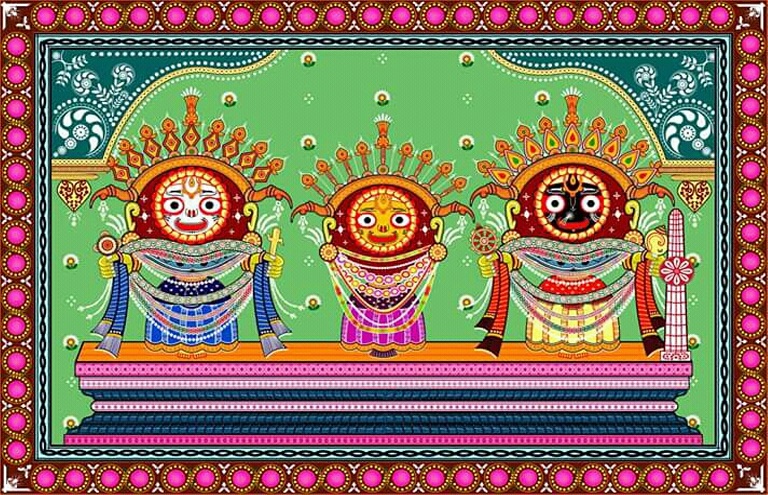
https://indianartideas.in/artwork/jagannath-balabhadra-subhadra/14985
Patachitra is the fabric scroll painting custom from Odisha, committed to legendary and strict subjects. Striking, solid layouts, lively shadings like white, red yellow, and dark with improving boundaries are a portion of the qualities of patachitra painting style, that is respected by craftsmanship sweethearts across the world.
What Does A Patachitra Painting Consist Of?
- Pattachitra is a transcendental symbol painting.
- A portion of the well-known topics of this strict craftsmanship is The Badhia (a portrayal of the sanctuary of Jagannath); Krishna Lila (an institution of Jagannath as Lord Krishna showing his forces as a youngster); Dasabatara Patti (the ten manifestations of Lord Vishnu); and Panchamukhi (a portrayal of Lord Ganesh as a five-headed god). Consistently during Debasnana Purnima in Puri Jagannath Temple, the gods are accepted to clean up with 108 pots of cold water to battle the warmth of summer.
- A while later, the divinities fall and are wiped out for a time of 15 days known as 'Anasara.'
- Because of the gods' nonattendance from general visibility, probably the best Chitrakars are assembled to make three Pattachita works of art of the three gods — specifically Lord Jagannath, Goddess Subhadra, and Lord Balabhadra — for people in general to pay deference. These compositions are called Anasar Patti.
Read More: Time Travel with Traditional Indian Art
Wrap Up:
While we hold a much longer list of traditional Indian Art, making sure that we cover a few were important. In case you get a punch of redecorating your walls, get in touch with experts at Indian Art Ideas- one of the best online art galleries- for some magical experience with just the traditional art you need.
Hold on to the best deals and keep reading with us for outstanding knowledge on traditional paintings! Get all your answers with us!











